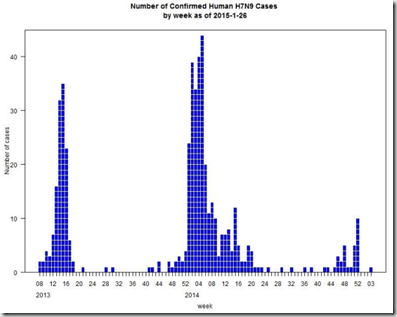# 9644
Although dated the 26th, I believe this latest Influenza at the Human-Animal Interface report from the World Health Organization only went live on their website overnight. In it, they list 24 new H5N1 cases in Egypt since their January 6th report, some of which saw the onset of their illness in late 2014.
The abundance of yellow in the epidemiological curve chart (below) for Nov-Dec-Jan illustrate how big Egypt’s latest outbreak of H5N1 really is, compared to other outbreaks we’ve followed. We’ve not seen this kind of concentrated human infection activity since the `bad old days’ of 2005, in Vietnam.
The good news is, that although another family cluster was reported in this latest batch of cases (siblings with onset the same onset dates, suggesting a mutually shared environment exposure), there are no signs of enhanced human-to-human transmission of this virus. The risk still appears to be from direct contact with infected birds.
Some excerpts from today’s report follow:
Influenza at the human-animal interface
Summary and assessment as of 26 January 2015Human infection with avian influenza A(H5) viruses
From 2003 through 23 January 2015, 718 laboratory-confirmed human cases of avian influenza A(H5N1) virus infection have been officially reported to WHO from 16 countries. Of these cases, 413 have died. Since the last WHO Influenza update on 6 January 2015, 24 new laboratory confirmed human cases of avian influenza A(H5N1) virus infection, including 11 fatal cases, were reported to WHO from Egypt. Of the 24 cases, seven had onset of disease in December 2014 and the rest had onset of disease in January 2015. The cases were reported from nine different governorates of Egypt (see table 1).Of the new cases, there was one cluster which included two confirmed cases in siblings from Assiut governorate. Both of these cases had disease onset on the same day and both had exposure to backyard poultry. All cases had exposure to poultry or poultry markets, except for three cases in which the sources of infection are still under investigation.
Currently, there are reports of an increased number of outbreaks and detections of influenza A(H5N1) viruses in poultry in Egypt compared to previous months and compared to this month in previous years.
The number of laboratory confirmed human cases of avian influenza A(H5N1) virus infection reported by Egypt in December was the highest reported by any country in a single month. Although all influenza viruses evolve over time, preliminary laboratory investigation has not detected major genetic changes in the viruses isolated from the patients or animals compared to previously circulating isolates. The increase in the number of human cases is likely attributed to a mixture of factors, including increased circulation of influenza A(H5N1) viruses in poultry, lower public health awareness of risks in middle and upper Egypt and seasonal factors such as closer proximity to poultry because of cold weather and possible longer survival of the viruses in the environment. Epidemiological and virological investigation in humans and animals is ongoing.
Various other H5 subtypes, such as influenza A(H5N2), A(H5N3), A(H5N6) and A(H5N8), have recently been detected in poultry in Europe, North America, and Asia, according to reports received by OIE. Although these influenza A(H5) viruses might have the potential to cause disease in humans, so far no human cases of infection have been reported, with exception of the 2 human infections with influenza A(H5N6) virus detected in China in 2014.
Overall public health risk assessment for avian influenza A(H5) viruses: Whenever avian influenza viruses are circulating in poultry, sporadic infections and small clusters of human cases are possible in people exposed to infected poultry or contaminated environments. Human infections remain so far rare and these influenza A(H5) viruses do not currently appear to transmit easily among people. As such, the risk of community-level spread of these viruses remains to be low.
Although H7N9 cases are documented elsewhere on the WHO site, this document also provides a brief summary of China’s recent activity as well.
Human infection with avian influenza A(H7N9) viruses
A total of 486 laboratory-confirmed cases of human infection with avian influenza A(H7N9) virus, including 185 deaths, have been reported to WHO: 469 cases by China National Health and Family Planning Commission, four cases by the Taipei Centers for Disease Control (Taipei CDC), 12 cases by the Centre for Health Protection, China, Hong Kong SAR, and one case in a Chinese traveler, reported from Malaysia.
The majority of recently reported human cases are associated with exposure to infected live poultry or contaminated environments, including markets where live poultry are sold. A(H7N9) viruses continue to be detected in poultry and their environments in the areas where human cases are occurring. There have been no major genetic changes in the viruses isolated from recent patients compared to previously isolated viruses from humans. Information to date suggests that these viruses do not transmit easily from human to human.
Overall public health risk assessment for avian influenza A(H7N9) viruses: Overall, the public health risk from avian influenza A(H7N9) viruses has not changed since the assessment published on 2 October 2014.


